Dimensionless Study of Double Lungs on Secretion Clearance of a Pressure-Controlled Mechanical Ventilation System
Abstract
Featured Application
Abstract
1. Introduction
2. Introduction of the Mechanical Ventilation System of Double Lungs
2.1. Secretion Clearance Ventilation System with Double Lungs
2.2. Mathematical Modeling of Mechanical Ventilation System with Double Lungs
- (1)
- The gas in the system is all ideal gas;
- (2)
- There is no air leakage during the working process;
- (3)
- Temperature remains constant during the working process;
- (4)
- Dynamic process of the system is a balanced process;
- (5)
- The state parameters of the air, such as density, specific heat and so on, remain unchanged at any place.
2.3. Mass Flow Equation
2.4. Volume Flow Equation
2.5. Pressure Equation
2.6. Volume Equation
2.7. Dimensionless Model of Secretion Clearance Mechanical Ventilation System
2.8. Dimensionless Compliance
2.9. Dimensionless Air Resistance
2.10. Dimensionless Flow Equation
2.11. Dimensionless Pressure Equation
2.12. Dimensionless Volume Equation
2.14. Dimensionless Peak Suction Flow
3. Simulation and Experimental Study on the Mechanical Ventilation System
3.1. Experimental Apparatus
3.2. Simulation of the Ventilation System
3.3. Analysis and Discussions
- (1)
- The simulation curve is consistent with the experimental curve.
- (2)
- The radian of the pressure experiment curve is greater than that of the pressure simulation curve, and the slope of pressure simulation curve is larger. The reason is that there is a delay in the response time.
- (3)
- The maximum and minimum of simulation curve and experiment curve are the same. The maximum of dimensionless pressure is about 1, which is dimensionless IPAP. In addition, the minimum is about 1, which is dimensionless EPAP. The experimental parameters of ventilator settings agree with the experimental curves. Therefore the experimental data is safe and reliable.
4. Working Characteristics of the Secretion Clearance Ventilation System with Double Lungs
4.1. Influence of Dimensionless Compliance and Dimensionless Air Resistance on Secretion Clearance Ventilation System
4.2. Influence of Dimensionless Compliance on Secretion Clearance Ventilation System with Double Lungs
4.3. Influence of Dimensionless Air Resistance on Secretion Clearance Ventilation System with Double Lungs
4.4. Orthogonal Experimental
5. Conclusions
Author Contributions
Funding
Conflicts of Interest
Nomenclature
| Ae | Effective area of throttle (mm2) |
| b | Critical pressure ratio = 0.528 |
| C | Respiratory compliance (L/cmH2O) |
| m | Mass of air (kg) |
| p | Pressure (pa) |
| q | Air mass flow (kg/s) |
| R’ | Gas constant = 287 (J/(kg·K)) |
| R | Respiratory resistance (cmH2O/L/s) |
| Temperature (K) | |
| t | Time (s) |
| V | Volume (m3) |
| ρ | Density (kg/m3) |
| k | Specific heat ratio = 1.4 |
| Subscripts | |
| a | Atmosphere |
| e | Expiration |
| epap | Expiatory positive airway pressure |
| ipap | Inspiratory positive airway pressure |
| l | Left |
| r | Right |
| ri | Rise |
| s | Sum |
| t | Tidal |
| d | Downstream side |
| u | Upstream side |
| v | Ventilator or ventilation process |
| p | Peak value |
| s | suction |
| d | duration |
References
- Wang, A.; Mahfouf, M.; Mills, G.H.; Panoutsos, G.; Linkens, D.A.; Goode, K.; Kwok, H.F.; Denaï, M. Intelligent model-based advisory system for the management of ventilated intensive care patients. Part II: Advisory system design and evaluation. Comput. Methods Prog. Biomed. 2010, 99, 208–217. [Google Scholar] [CrossRef] [PubMed]
- Williams, K.; Hinojosa-Kurtzberg, M.; Parthasarathy, S. Control of Breathing During Mechanical Ventilation: Who Is the Boss? Respir. Care 2010, 56, 127–136. [Google Scholar] [CrossRef] [PubMed]
- Shi, Y.; Niu, J.; Cai, M.; Xu, W. Dimensionless Study on Dynamics of Pressure Controlled Mechanical Ventilation System. J. Mech. Sci. Technol. 2015, 29, 431–439. [Google Scholar] [CrossRef]
- Ionescu, C.; Derom, E.; de Keyser, R. Assessment of respiratory mechanical properties with constant-phase models in healthy and COPD lungs. Comput. Methods Prog. Biomed. 2010, 97, 78–85. [Google Scholar] [CrossRef] [PubMed]
- Chmielecki, J.; Foo, J.; Oxnard, G.R.; Hutchinson, K.; Ohashi, K.; Somwar, R.; Wang, L.; Amato, K.R.; Arcila, M.; Sos, M.L.; et al. Optimization of dosing for EGFRmutant non-small cell lung cancer with evolutionary cancer modeling. Sci. Transl. Med. 2011, 3. [Google Scholar] [CrossRef] [PubMed]
- Shi, Y.; Niu, J.; Cao, Z.; Cai, M.; Zhu, J. Working Characteristics of a New Ventilator with Automatic Secretion Clearance Function. Sci. China Technol. Sci. 2015, 58, 1046–1052. [Google Scholar] [CrossRef]
- Koc, H.; King, J.; Teschl, G.; Unterkofler, K.; Teschl, S.; Mochalski, P.; Hinterhuber, H.; Amann, A. The role of mathematical modeling in VOC analysis using isoprene as a prototypic example. J. Breath Res. 2011, 5, 037102. [Google Scholar] [CrossRef] [PubMed]
- Szaleniec, J.; Składzień, J.; Tadeusiewicz, R.; Oleś, K.; Konior, M.; Przeklasa, R. How can an otolaryngologist benet from arti cial neural networks? Otolaryngol. Pol. 2012, 66, 241–248. [Google Scholar] [CrossRef] [PubMed]
- Sturm, R. A computer model for the simulation of ber-cell interaction in the alveolar region of the respiratory tract. Comput. Biol. Med. 2011, 41, 565–573. [Google Scholar] [CrossRef] [PubMed]
- Shi, Y.; Zhang, B.; Wang, Z.; Cai, M.; Shen, D. New Advances in Monitoring and Triggering of Mechanical Ventilation. Sci. China Technol. Sci. 2016, 59, 1791–1792. [Google Scholar] [CrossRef]
- Katori, H.; Tsukuda, M. Acute epiglottitis: Analysis of factors associated with airway intervention. J. Laryngol. Otol. 2005, 12, 967–972. [Google Scholar] [CrossRef] [PubMed]
- Guldfred, L.A.; Lyhne, D.; Becker, B.C. Acute epiglottitis: Epidemiology, clinical presentation, management and outcome. J. Laryngol. Otol. 2008, 122, 818–823. [Google Scholar] [CrossRef] [PubMed]
- Gerber, V.; Robinson, N.E. Airway Secretions and Mucociliary Function. Equine Respiratory Medicine and Surgery; Elsevier: Amsterdam, The Netherlands, 2007; pp. 55–69. [Google Scholar]
- Rose, L.; Hanlon, G. Ventilation and Oxygenation Management. ACCCN’s Critical Care Nursing; Elsevier: Amsterdam, The Netherlands, 2011; p. 381. [Google Scholar]
- Shi, Y.; Niu, J.; Cai, M.; Xu, W. Dimensionless optimization study on a ventilator with secretion clearance function. J. Mech. Med. Biol. 2015, 15, 1550032. [Google Scholar] [CrossRef]
- Feltracco, P.; Falasco, G.; Barbieri, S.; Milevoj, M.; Serra, E.; Ori, C. Anesthetic considerations for nontransplant procedures in lung transplant patients. J. Clin. Anesth. 2011, 23, 508–516. [Google Scholar] [CrossRef] [PubMed]
- Avinash, S.; Carli, F. The Role of Regional Anaesthesia in Patient Outcome: Thoracic and Abdominal Surgeries. Techniques in Regional Anesthesia and Pain Management; Elsevier: Amsterdam, The Netherlands, 2008; pp. 183–193. [Google Scholar]
- Dyhr, T.; Bonde, J.; Larsson, A. Lung recruitment manoeuvres are effective in regaining lung volume and oxygenation after open endotracheal suctioning in acute respiratory distress syndrome. Crit. Care 2003, 7, 55–62. [Google Scholar] [CrossRef] [PubMed]
- Maggiore, S.M.; Lellouche, F.; Pigeot, J.; Taille, S.; Deye, N.; Durrmeyer, X.; Richard, J.C.; Mancebo, J.; Lemaire, F.; Brochard, L. Prevention of endotracheal suctioninginduced alveolar derecruitment in acute lung injury. Am. J. Respir. Crit. Care Med. 2003, 167, 1215–1224. [Google Scholar] [CrossRef] [PubMed]
- Munnur, U.; Bandi, V.D.; Gropper, M.A. Airway Management and Mechanical Ventilation in Pregnancy, Pulmonary Problems in Pregnancy; Humana Press: New York, NY, USA, 2009; pp. 385–403. [Google Scholar]
- Morrissey, B.M. Pathogenesis of bronchiectasis. Clin. Chest Med. 2007, 28, 289–296. [Google Scholar] [CrossRef] [PubMed]
- Tsoumakidou, M.; Siafakas, N.M. Novel insights into the aetiology and pathophysiology of increased airway inflammation during COPD exacerbations. Respir. Res. 2006, 7, 1186–1465. [Google Scholar] [CrossRef] [PubMed]
- Huh, D.; Fujioka, H.; Tung, Y.-C.; Futai, N.; Paine, R., III; Grotberg, J.B.; Takayama, S. Acoustically detectable cellular-level lung injury induced by fluid mechanical stresses in microfluidic airway systems. Nat. Acad. Sci. 2007, 104, 18886–18891. [Google Scholar] [CrossRef] [PubMed]
- Safdar, N.; Crnich, C.J.; Maki, D.G. The pathogenesis of ventilator-associated pneumonia: Its relevance to developing effective strategies for prevention. Respir. Care 2005, 50, 725–741. [Google Scholar] [PubMed]
- Branson, R.D. Secretion management in the mechanically ventilated patient. Respir. Care 2007, 52, 1328–1347. [Google Scholar] [PubMed]
- Hess, D.R. Patient positioning and ventilator-associated pneumonia. Respir. Care 2005, 50, 892–899. [Google Scholar] [PubMed]
- Redlarski, G.; Jaworski, J. A new approach to modeling of selected human respiratory system diseases, directed to computer simulations. Comput. Biol. Med. 2013, 43, 1606–1613. [Google Scholar] [CrossRef] [PubMed]
- Eyles, J.G.; Pimmel, R.L. Estimating respiratory mechanical parameters in parallel compartment models. IEEE Trans. Biomed. Eng. 1981, 28, 313–317. [Google Scholar] [CrossRef] [PubMed]
- Diong, B.; Goldman, M.D.; Nazeran, H. Respiratory impedance values in adults are relatively insensitiveto mead model lung compliance and chest wall compliance parameters. In Proceedings of the 26th Southern Biomedical Engineering Conference (SBEC’10), College Park, MD, USA, 30 April–2 May 2010; pp. 201–203. [Google Scholar]
- Vassiliou, M.P.; Amygdalou, A.; Psarakis, C.J.; Dalavanga, Y.; Vassiliou, P.M.; Mandragos, K.E.; Constantopoulos, S.H.; Behrakis, P.K. Volume and flow dependence of respiratory mechanics in mechanically ventilated COPD patients. Respir. Physiol. Neurobiol. 2003, 135, 87–96. [Google Scholar] [CrossRef]
- Branson, R.D.; Johannigman, J.A.; Campbell, R.S.; Davis, K., Jr. Closed loop mechanical ventilation. Respir. Care 2002, 47, 427–451. [Google Scholar] [PubMed]
- Chatburn, R.L.; Mireles-Cabodevila, E. Closed-loop control of mechanical ventilation: Description and classification of targeting schemes. Respir. Care 2011, 56, 85–102. [Google Scholar] [CrossRef] [PubMed]
- Tehrani, F.T. Automatic control of mechanical ventilation. Part 2: The existing techniques and future trends. J. Clin. Monit. Comput. 2008, 22, 417–424. [Google Scholar] [CrossRef] [PubMed]
- Choi, E.M.; Na, S.; Choi, S.H.; An, J.; Rha, K.H.; Oh, Y.J. Comparison of volume-controlled and pressure-controlled ventilation in steep Trendelenburg position for robot-assisted laparoscopic radical prostatectomy. J. Clin. Anesth. 2011, 23, 183–188. [Google Scholar] [CrossRef] [PubMed]
- Karakurt, Z.; Yarkin, T.; Altinöz, H.; Atik Güngör, S.; Adigüzel, N.; Güngör, G.; Demiryontar, D.; Biçakçi, B.; Berk Takir, H.; Unver, E.; et al. Pressure vs. volume control in COPD patients intubated due to ARF: A case-control study. Tuberk uloz ve Toraks 2009, 57, 145–154. [Google Scholar]
- Robert, L. Computer control of mechanical ventilation. Respir. Care 2004, 49, 507–515. [Google Scholar]
- Borrello, M. Modeling and control of systems for critical care ventilation. In Proceedings of the 2005 American Control Conference, Portland, OR, USA, 8–10 June 2005; pp. 2166–2180. [Google Scholar]
- Shi, Y.; Ren, S.; Cai, M.; Xu, W.; Deng, Q. Pressure Dynamic Characteristics of Pressure Controlled Ventilation System of a Lung Simulator. Comput. Math. Methods Med. 2011, 10, 1155–1164. [Google Scholar] [CrossRef] [PubMed]
- Shi, Y.; Cai, M. Working characteristics of two kinds of air driven boosters. Energy Convers. Manag. 2011, 52, 3399–3407. [Google Scholar] [CrossRef]
- Liu, Y.; Pei, P. Asymptotic analysis on autoignition and explosion limits of hydrogen–oxygen mixtures in homogeneous systems. Int. J. Hydrogen Energy 2006, 31, 639–647. [Google Scholar] [CrossRef]
- Niu, J.; Shi, Y.; Cai, M.; Cao, Z.; Wang, D.; Zhang, Z.; Zhang, D.X. Detection of Sputum by Interpreting the Time-frequency Distribution of Respiratory Sound Signal Using Image Processing Techniques. Bioinformatics 2017. [Google Scholar] [CrossRef] [PubMed]
- Niu, J.L.; Shi, Y.; Cao, Z.X.; Cai, M.L.; Chen, W.; Zhu, J.; Xu, W. Study on air flow dynamic characteristic of mechanical ventilation of a lung simulator. Sci. China Technol. Sci. 2017, 60, 1–8. [Google Scholar] [CrossRef]
- Ren, S.; Shi, Y.; Cai, M.; Xu, W. Influence of secretion on airflow dynamics of mechanical ventilated respiratory system. IEEE/ACM Trans. Comput. Biol. Bioinform. 2017. [Google Scholar] [CrossRef] [PubMed]
- Shi, Y.; Zhang, B.; Cai, M.; Xu, W. Coupling Effect of Double Lungs on a VCV Ventilator with Automatic Secretion Clearance Function. IEEE/ACM Trans. Comput. Biol. Bioinform. 2017. [Google Scholar] [CrossRef] [PubMed]
- Shi, Y.; Zhang, B.; Cai, M.; Zhang, D. Numerical Simulation of volume-controlled mechanical ventilated respiratory system with two different lungs. Int. J. Numer. Methods Biomed. Eng. 2016, 33, 2852. [Google Scholar] [CrossRef] [PubMed]
- Ren, S.; Cai, M.; Shi, Y.; Xu, W.; Zhang, X.D. Influence of Bronchial Diameter Change on the airflow dynamics Based on a Pressure-controlled Ventilation System. Int. J. Numer. Methods Biomed. Eng. 2017. [Google Scholar] [CrossRef] [PubMed]
- Shi, Y.; Niu, J.; Cao, Z.; Cai, M.; Zhu, J.; Xu, W. Online estimation method for respiratory parameters based on a pneumatic model. IEEE/ACM Trans. Comput. Biol. Bioinform. 2016, 13, 939–946. [Google Scholar] [CrossRef] [PubMed]
- Diong, B.; Goldman, M.; Nazeran, H. Respiratory impedance values in adults are relatively insensitive to mead model lung compliance and chest wall compliance parameters. Proc. IFMBE 2010, 32, 201–203. [Google Scholar]
- Shi, Y.; Ren, S.; Cai, M.; Xu, W. Modelling and simulation of volume controlled mechanical ventilation system. Math. Probl. Eng. 2014, 2014. [Google Scholar] [CrossRef]
- Shi, Y.; Ren, S.; Cai, M.; Xu, W. Working characteristics of a mechanical insufflation-exsufflation device. Math. Probl. Eng. 2014, 2014. [Google Scholar] [CrossRef]
- Shi, Y.; Wang, Y.; Cai, M.; Zhang, B.; Zhu, J. Study on the Aviation Oxygen Supply System Based on a Mechanical Ventilation Model. Chin. J. Aeronaut. 2017. [Google Scholar] [CrossRef]
- Shi, Y.; Wang, Y.; Liang, H.; Cai, M. Power characteristics of a new kind of air-powered vehicle. Int. J. Energy Res. 2016, 40, 1112–1121. [Google Scholar] [CrossRef]
- Cai, M.; Wang, Y.; Shi, Y.; Liang, H. Output dynamic control of a late model sustainable energy automobile system with nonlinearity. Adv. Mech. Eng. 2016, 8. [Google Scholar] [CrossRef]
- Shi, Y.; Wu, T.; Cai, M.; Wang, Y.; Xu, W. Energy conversion characteristics of a hydropneumatic transformer in a sustainable-energy vehicle. Appl. Energy 2016, 171, 77–85. [Google Scholar] [CrossRef]

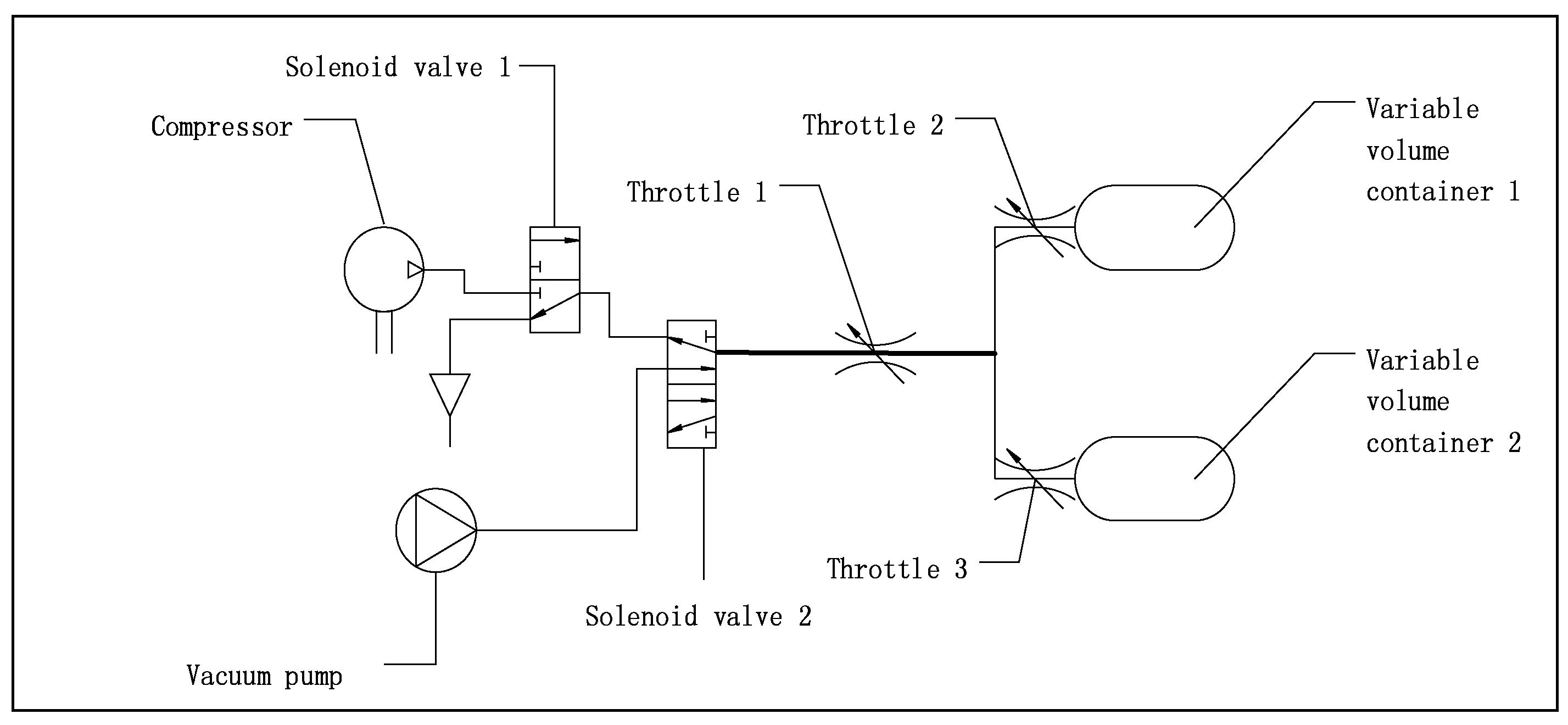

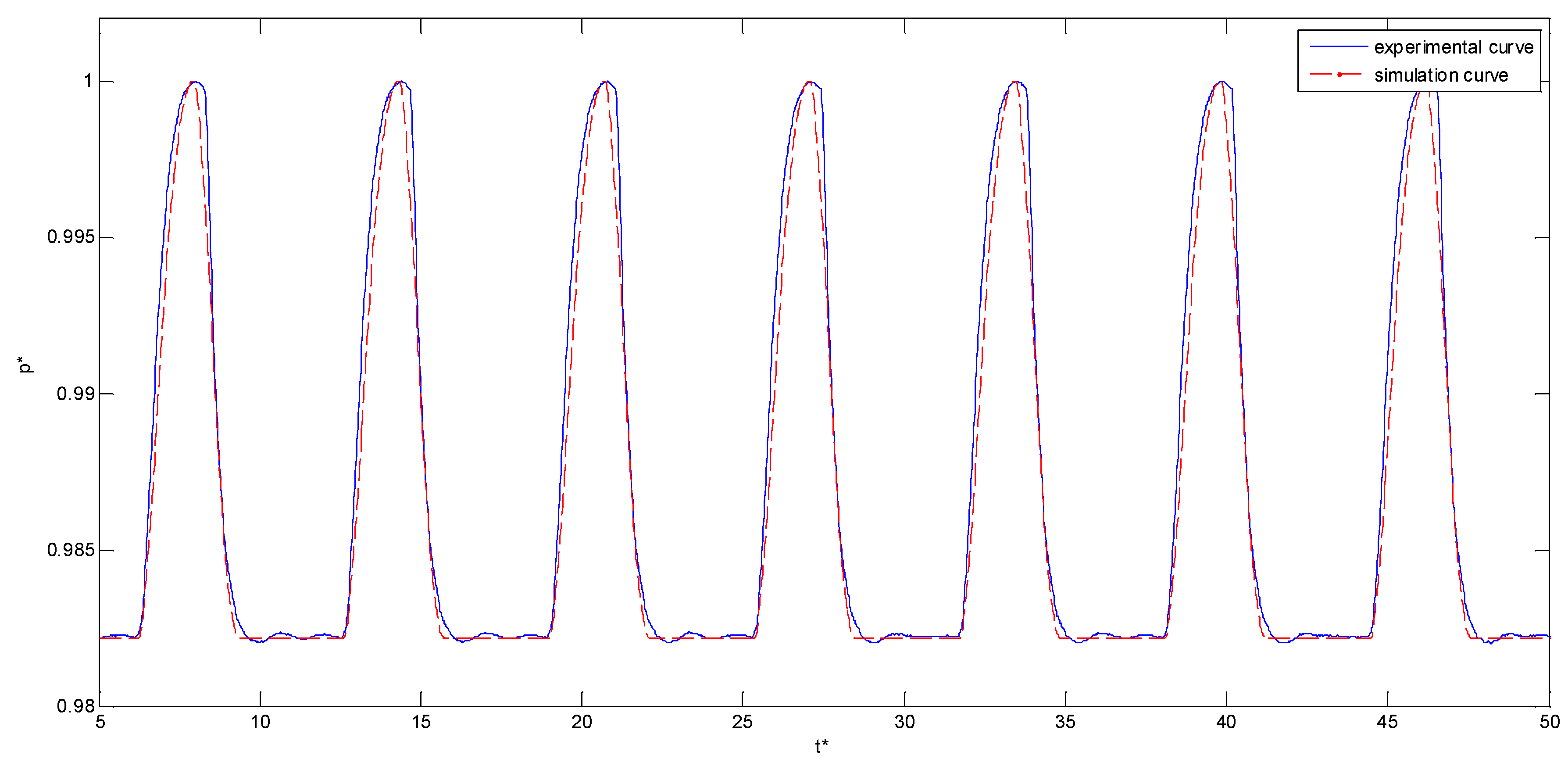
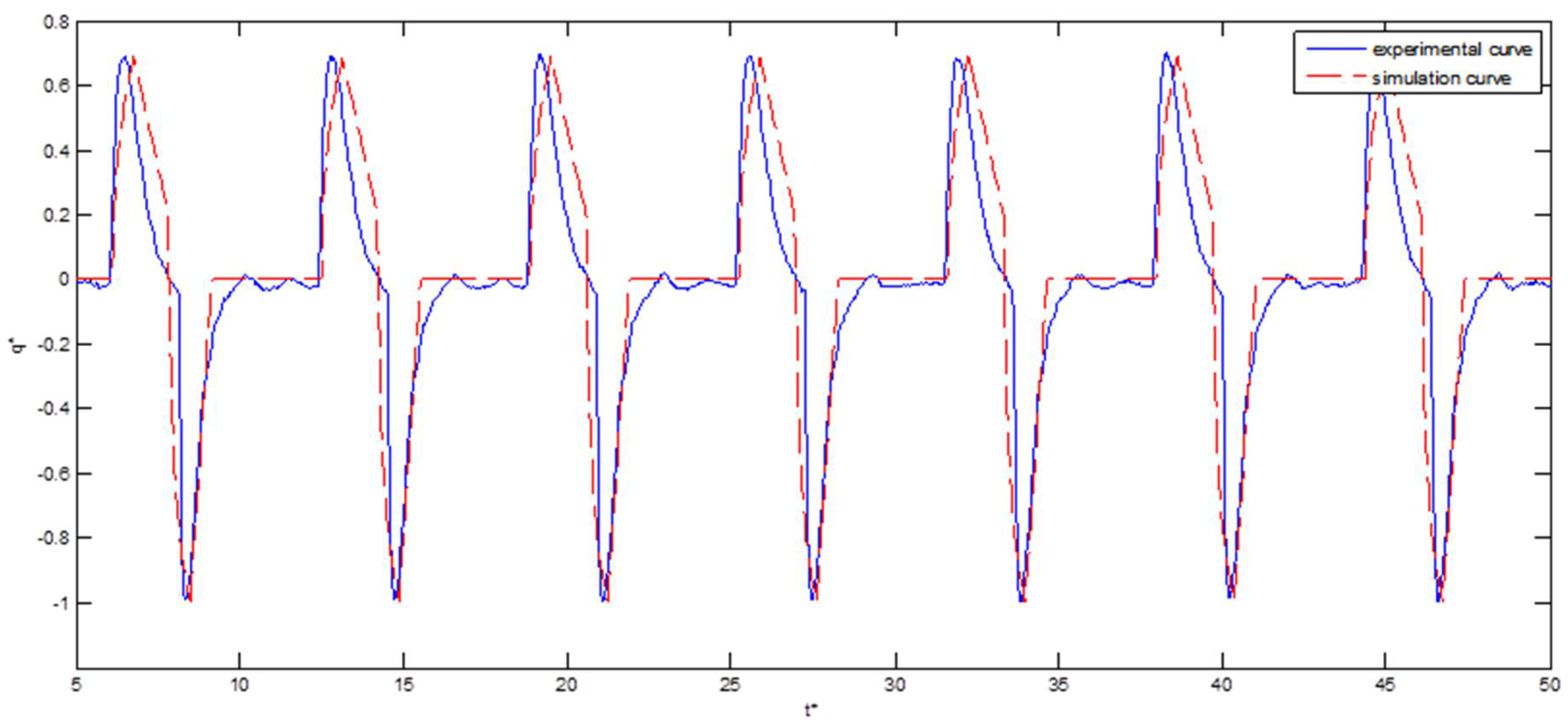
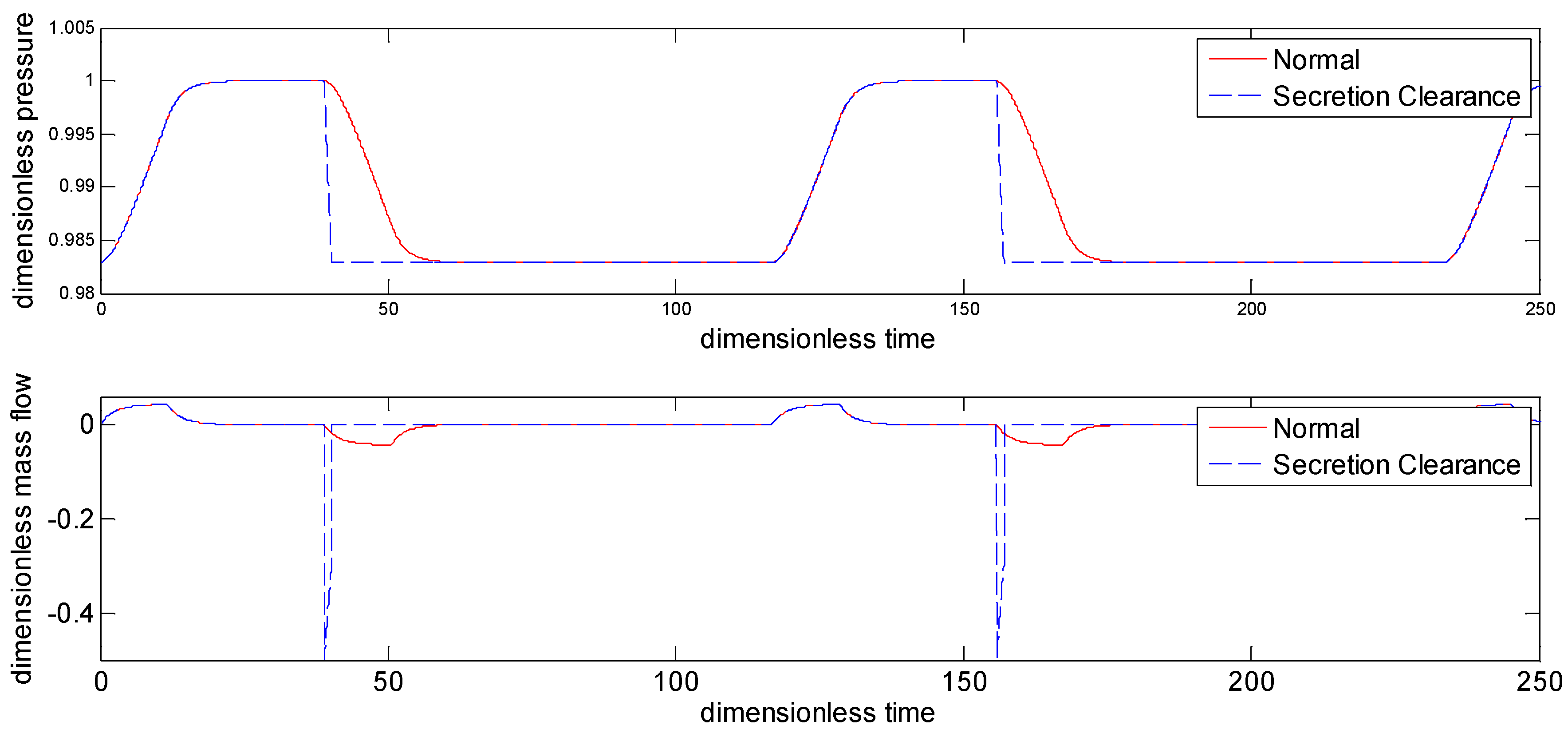
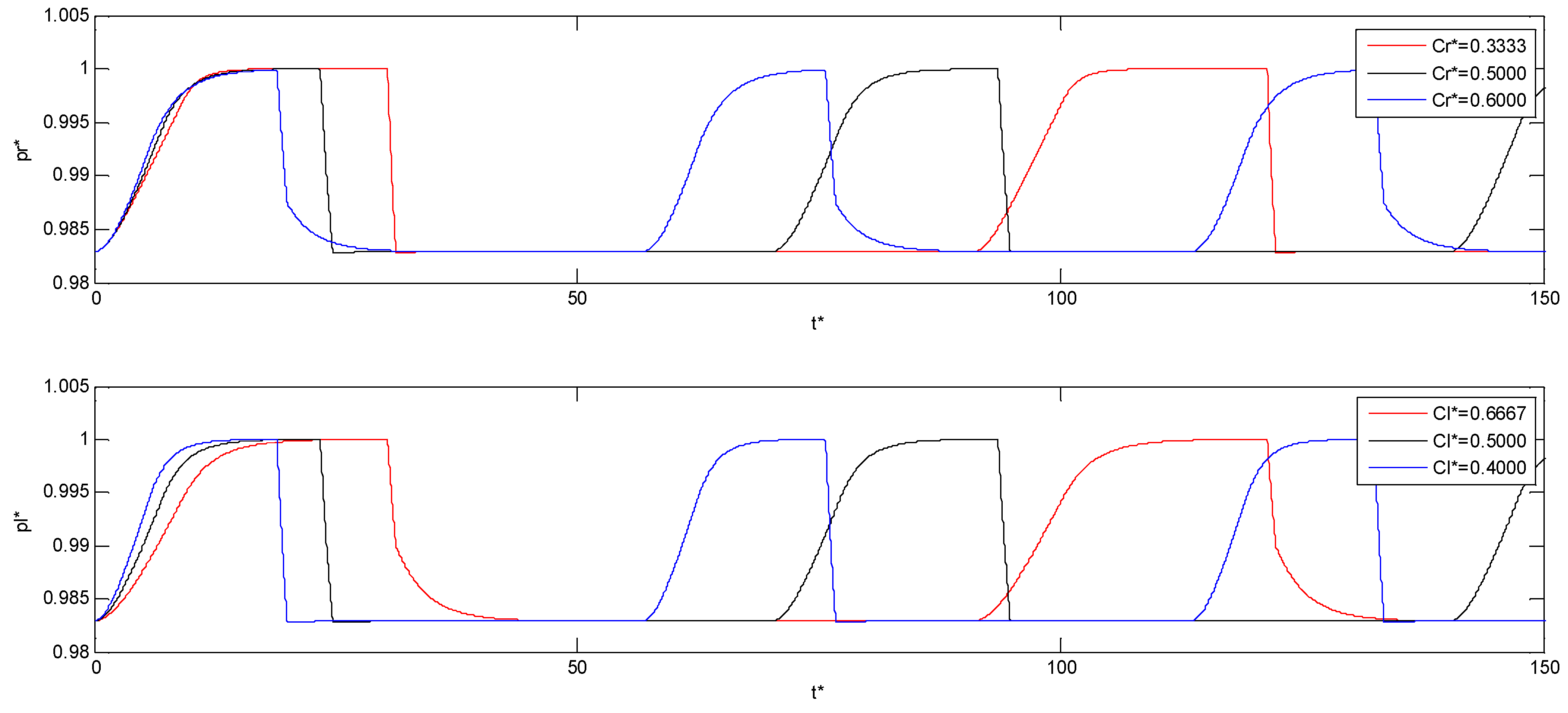

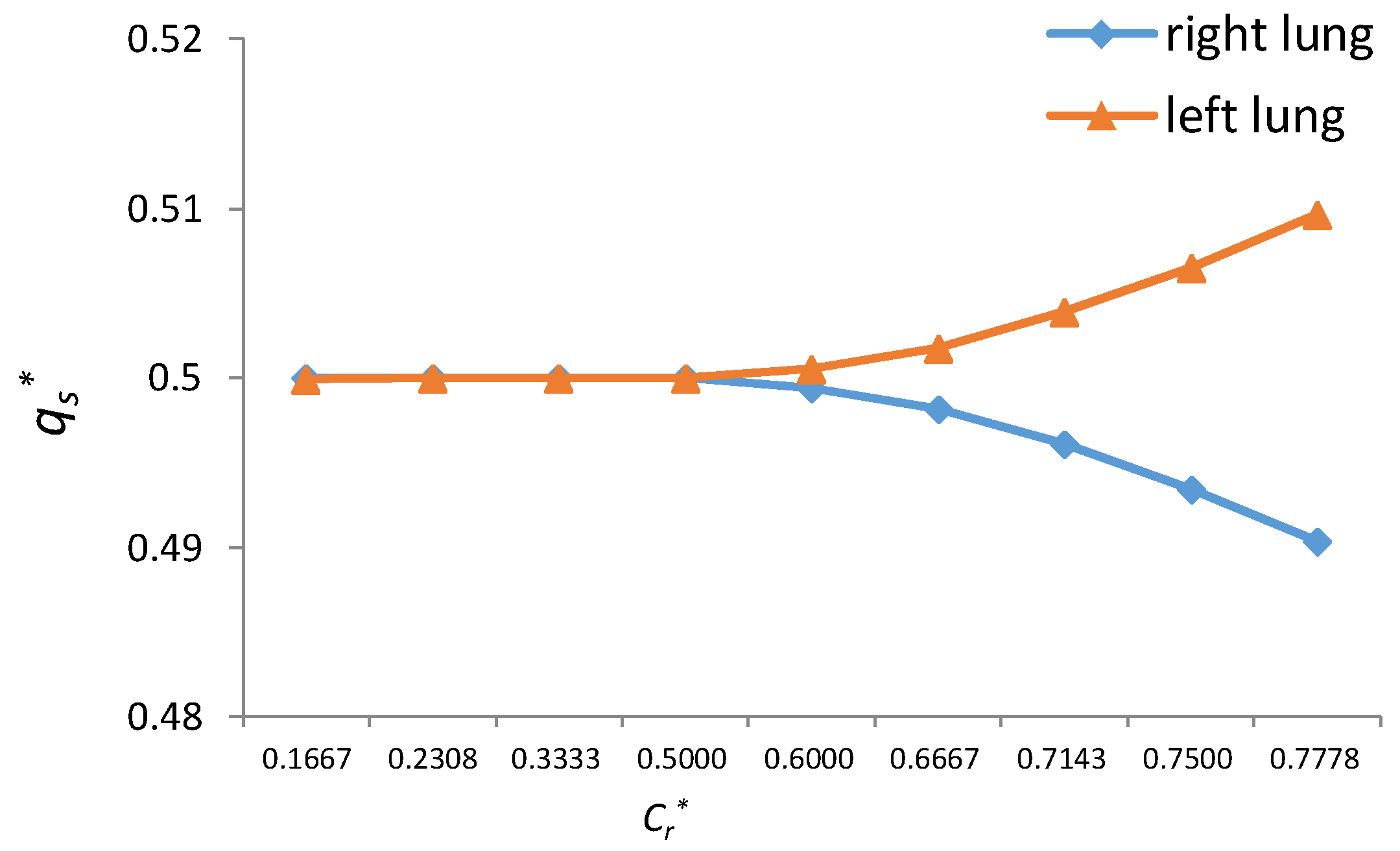
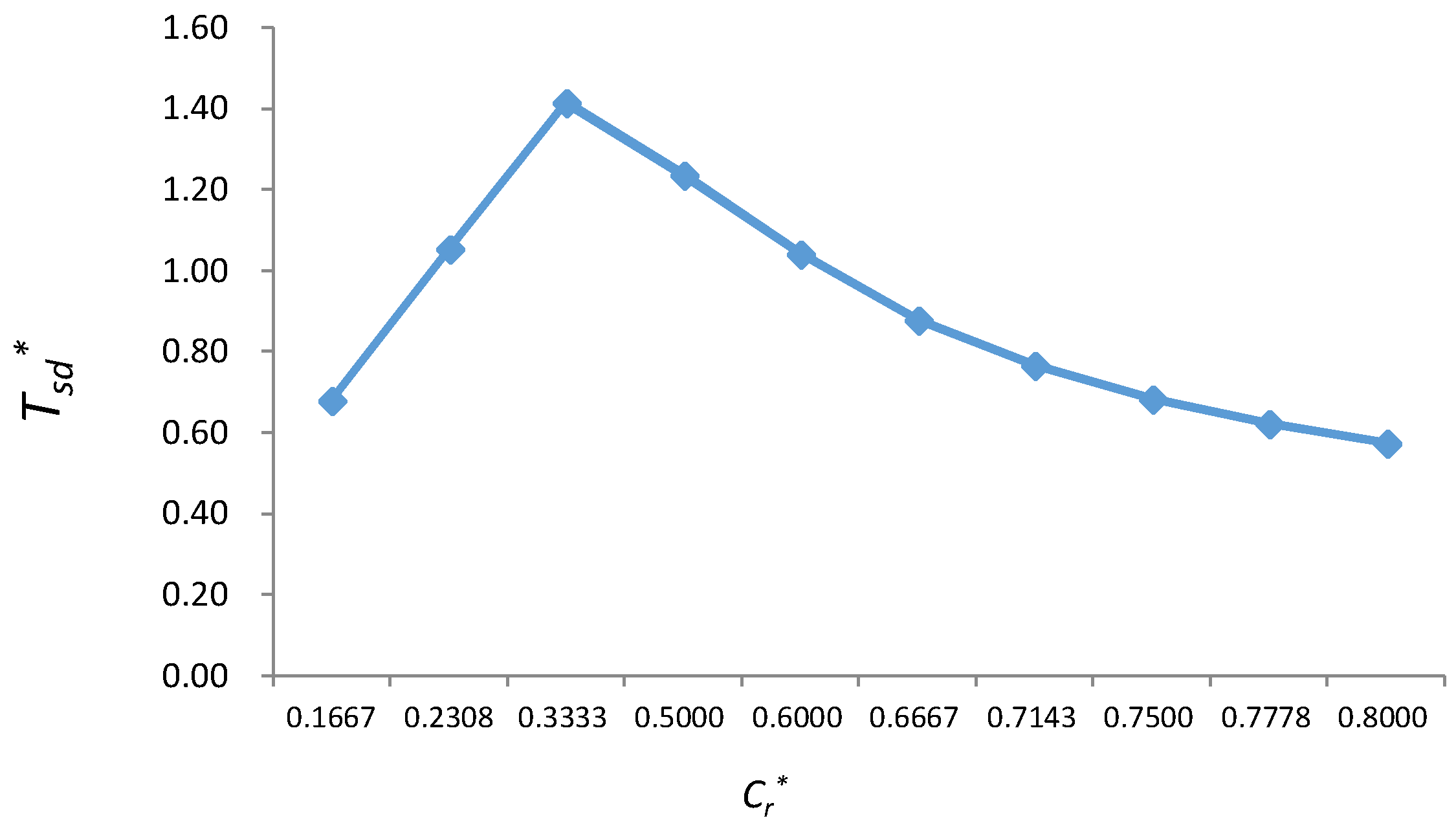
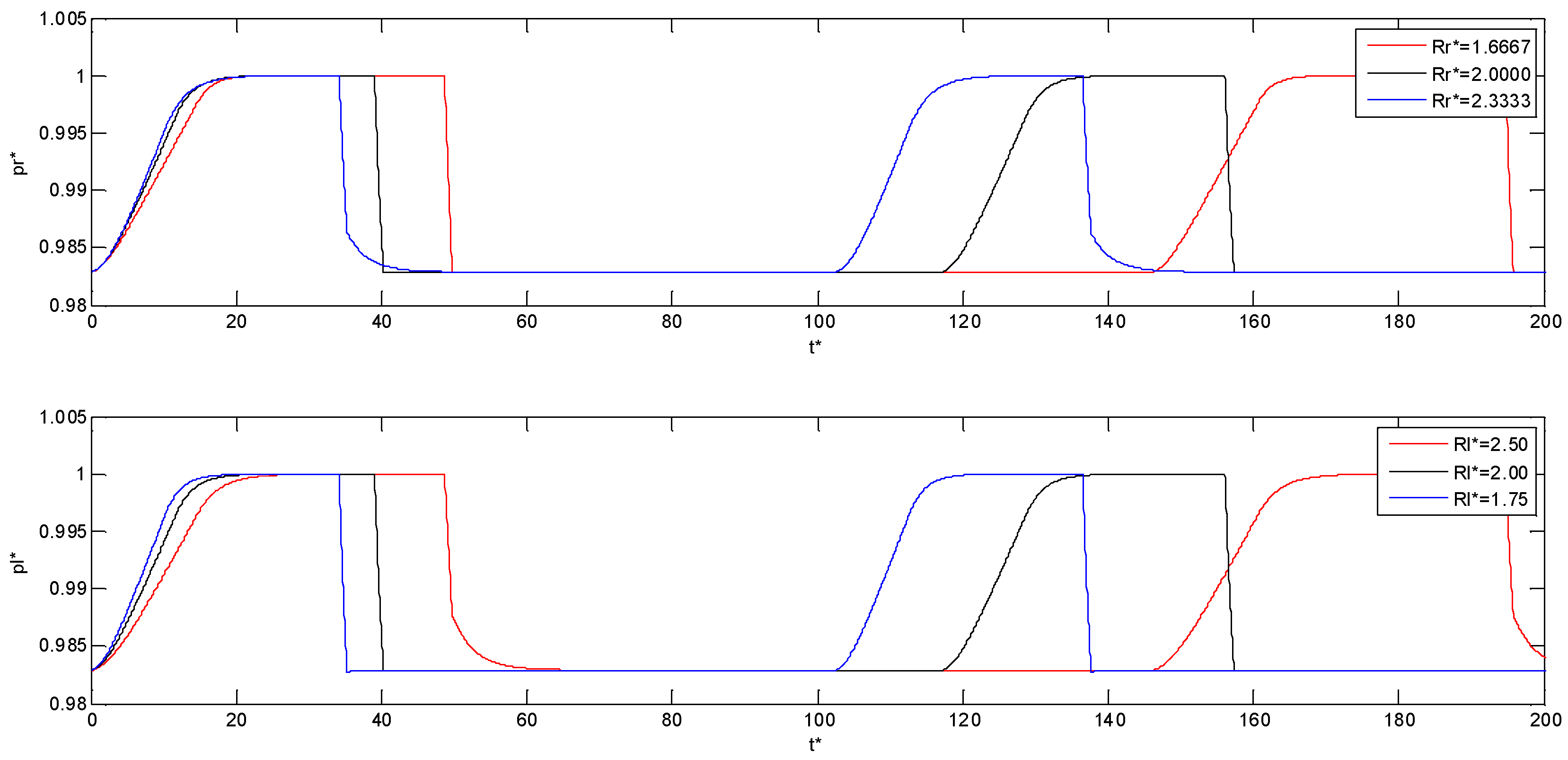
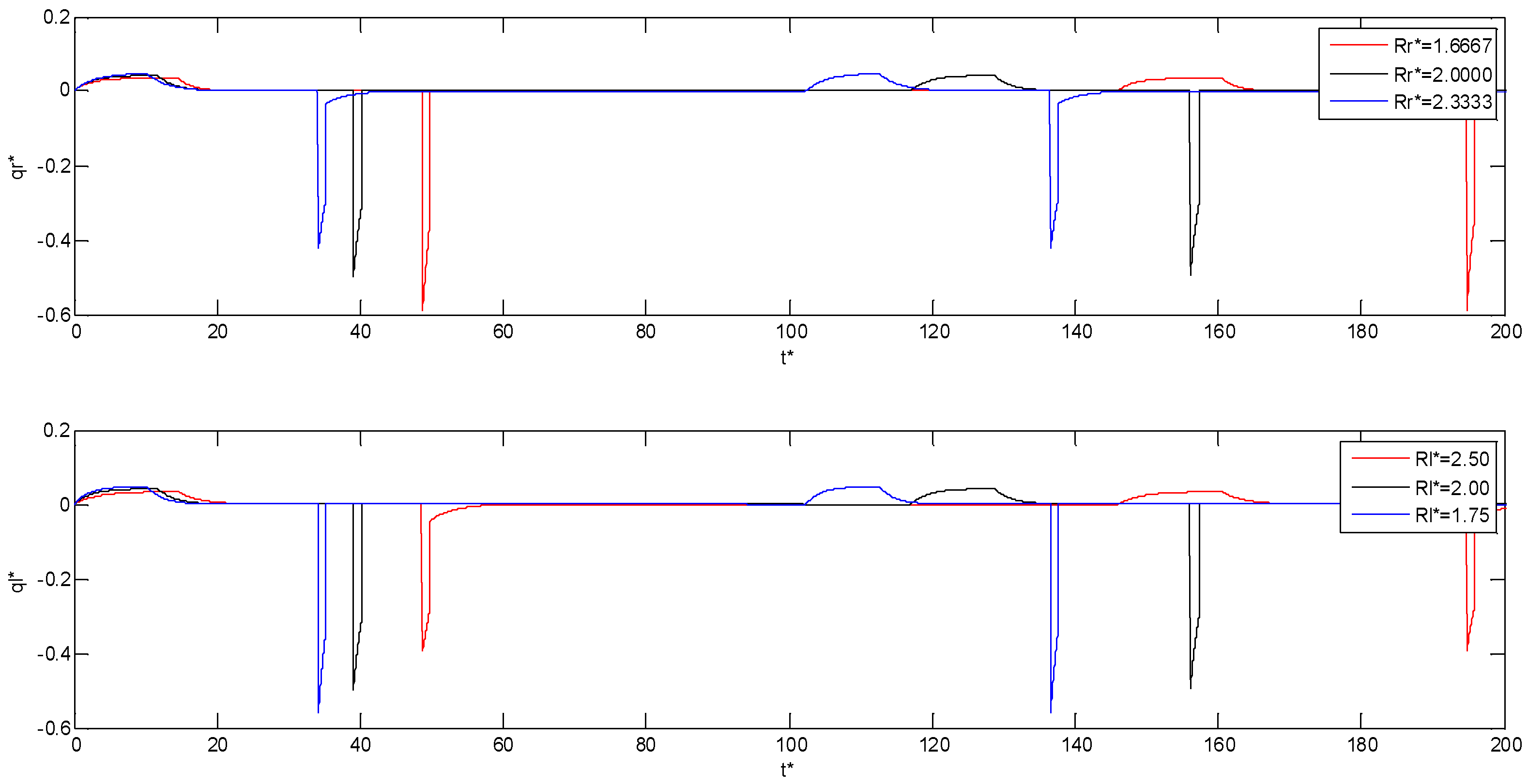
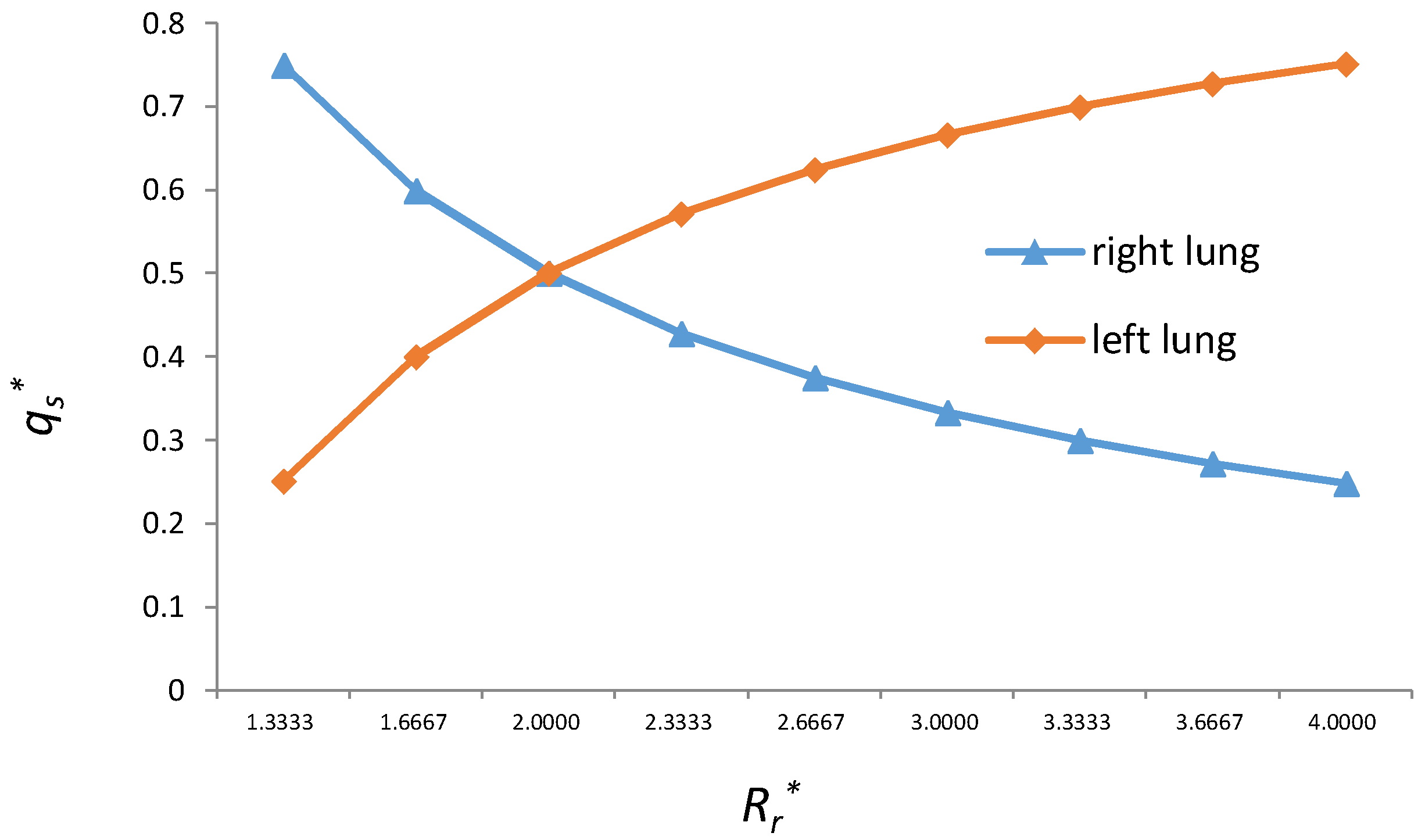
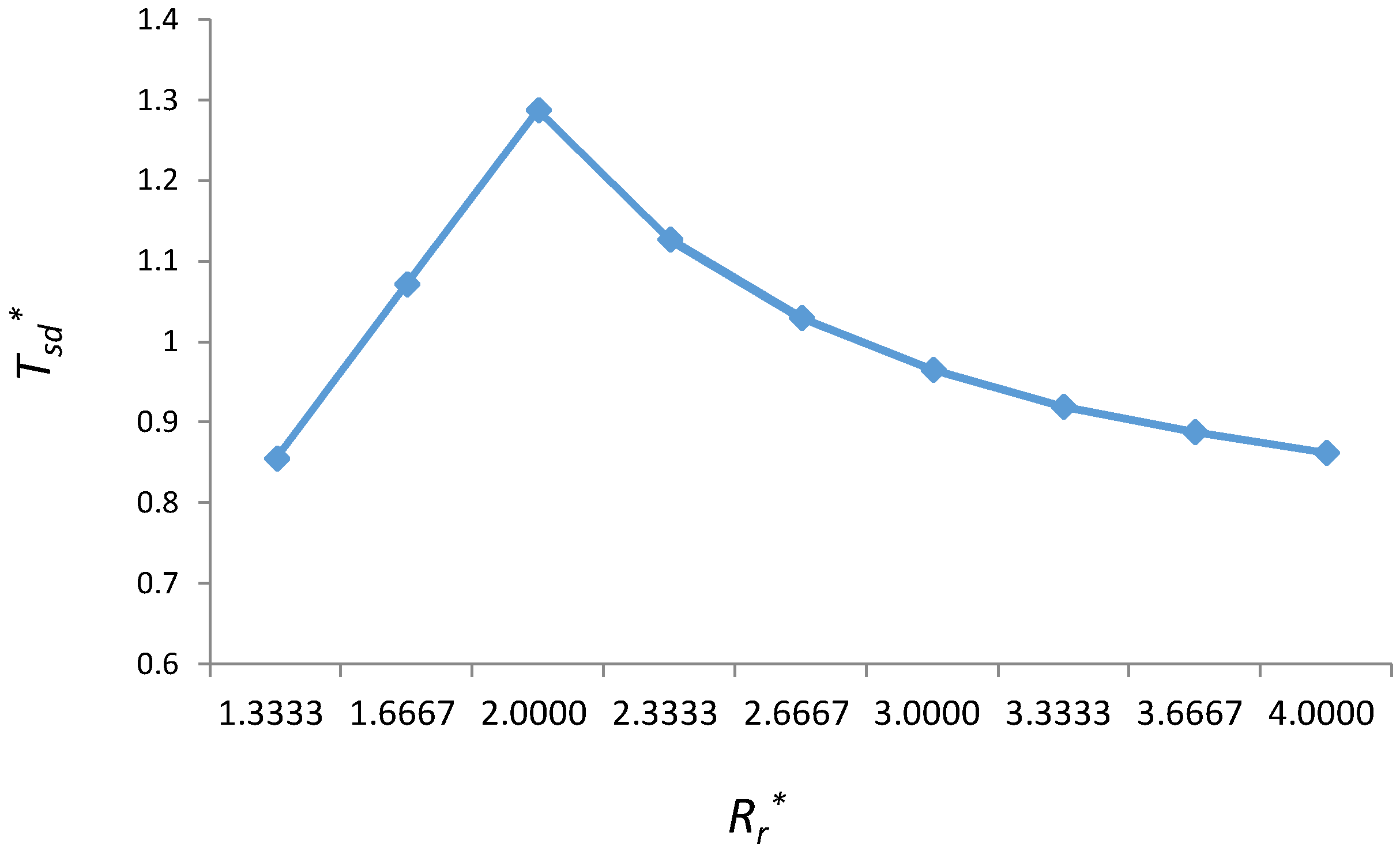
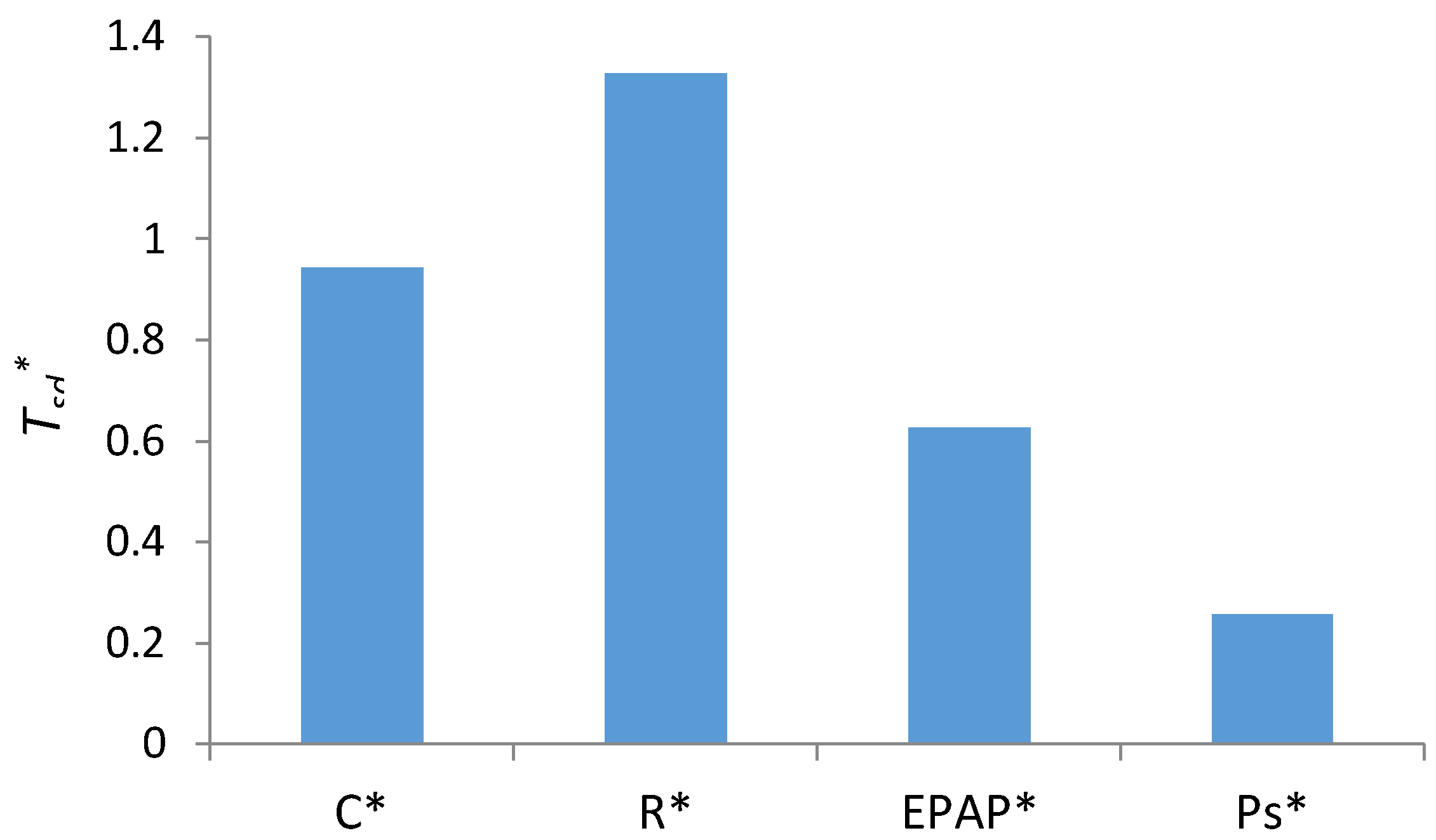
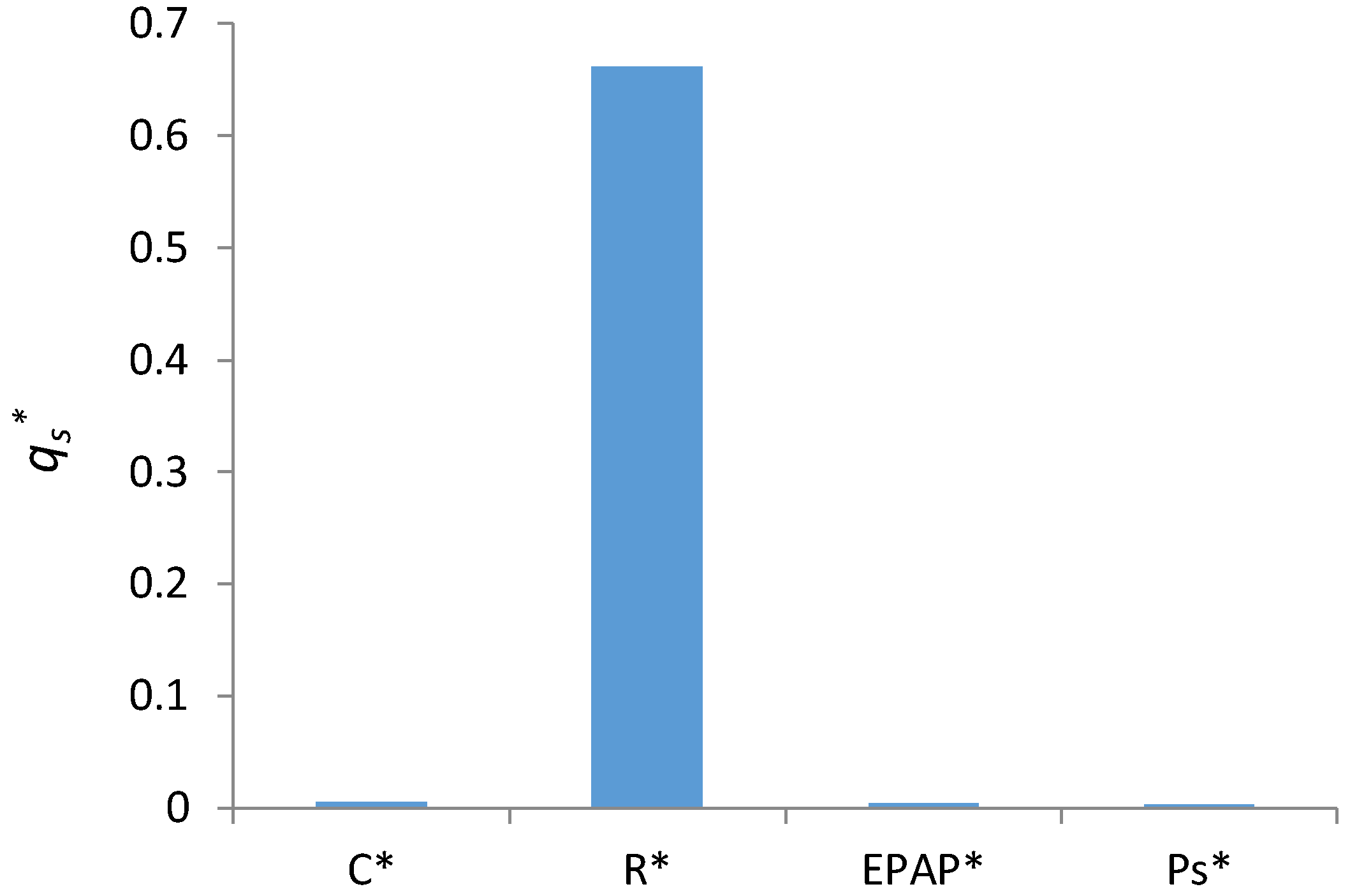
| Variable | Reference Value | Dimensionless Variable | |
|---|---|---|---|
| Air mass | Maximal air mass () of the whole system | ||
| Pressure | IPAP | ||
| Air mass flow | Maximum air mass flow through the throttle | ||
| Time | Time to totally exhaust of air at of air mass flow | ||
| Volume | Tidal volume | ||
| Compliance | Ration of and | ||
| Air resistance | Total air resistance of the system | ||
© 2018 by the authors. Licensee MDPI, Basel, Switzerland. This article is an open access article distributed under the terms and conditions of the Creative Commons Attribution (CC BY) license (http://creativecommons.org/licenses/by/4.0/).
Share and Cite
Shen, D.; Zhang, Q.; Wang, Y. Dimensionless Study of Double Lungs on Secretion Clearance of a Pressure-Controlled Mechanical Ventilation System. Appl. Sci. 2018, 8, 1078. https://doi.org/10.3390/app8071078
Shen D, Zhang Q, Wang Y. Dimensionless Study of Double Lungs on Secretion Clearance of a Pressure-Controlled Mechanical Ventilation System. Applied Sciences. 2018; 8(7):1078. https://doi.org/10.3390/app8071078
Chicago/Turabian StyleShen, Dongkai, Qian Zhang, and Yixuan Wang. 2018. "Dimensionless Study of Double Lungs on Secretion Clearance of a Pressure-Controlled Mechanical Ventilation System" Applied Sciences 8, no. 7: 1078. https://doi.org/10.3390/app8071078
APA StyleShen, D., Zhang, Q., & Wang, Y. (2018). Dimensionless Study of Double Lungs on Secretion Clearance of a Pressure-Controlled Mechanical Ventilation System. Applied Sciences, 8(7), 1078. https://doi.org/10.3390/app8071078






